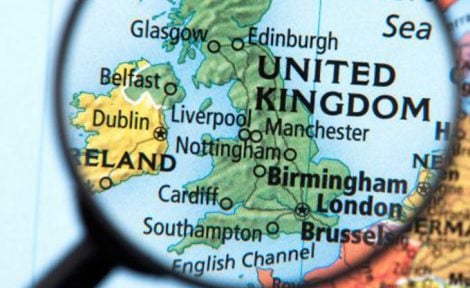Tipping point
House price expert Kate Faulkner of Designs on Property reports on the leading market indices, which are reporting a slow-down to a halt...
The headlines

Rightmove
Rate rises quash spring price bounce but activity holds up.
“Average new seller asking prices fall by £82 (-0.0%) this month to £372,812, the first monthly drop in asking prices this year and the first drop seen in the month of June since 2017.”
Home.co.uk
Lower marketing times and limited stock afford steady price growth.
“Asking prices across England and Wales rose again during May by 0.4% as the market shrugged off interest rate woes, although year-on-year growth slipped further into the negative again (-1.3%) due to the market correction late last year.”
Nationwide
House prices relatively stable in June but annual growth remains in negative territory.
“Annual house price growth was broadly stable at -3.5% in June, little changed from the 3.4% decline recorded in May. Prices were also fairly stable over the month, rising by a modest 0.1%, after taking account of seasonal effects, reversing the 0.1% decline seen in May.”
Halifax
House prices edge down as market cools amid higher interest rates.
“The average UK house price fell slightly in June, down by around £300 compared to May (-0.1%). This was the third consecutive monthly fall, albeit it a modest one. The annual drop of -2.6% is the largest year-on-year decrease since June 2011.”
E.surv
Tenth month of slowing annual rates of price growth…
“On an annual basis, the average sale price of completed home transactions in England and Wales in June 2023 rose by some £4,500, or 1.2%, and now stands at £371,204. This is the lowest rate of annual increase since May 2020, and is the tenth month in succession in which the annual rate of price inflation has fallen.”
Zoopla
Annual UK house price inflation +1.2%
“House price inflation slows to +1.2% as quarterly growth rate turns positive following pick-up in sales activity over Spring.”
There’s still a lot of positivity from the indices, but also some not-so-good news…
Latest house prices in historical context
 Kate says: Nearly all the indices are now either showing a fall in property prices or only slight growth, which over the next few months is likely to disappear. Zoopla correctly predicted that price falls will start feeding into the indices over the summer and with the latest increase in mortgage rates to 6%, that’s likely to spook even the hardiest of buyers. Having said that, there is a still a lot of positivity from the indices, but also some ‘not so good news’. Here’s a summary of their commentary:
Kate says: Nearly all the indices are now either showing a fall in property prices or only slight growth, which over the next few months is likely to disappear. Zoopla correctly predicted that price falls will start feeding into the indices over the summer and with the latest increase in mortgage rates to 6%, that’s likely to spook even the hardiest of buyers. Having said that, there is a still a lot of positivity from the indices, but also some ‘not so good news’. Here’s a summary of their commentary:
Rightmove
- Despite some significant increases in mortgage interest rates over the last few weeks, Rightmove’s statistics currently show no effect on buyer demand but a slight impact on sales activity.
- Buyer demand over the last two weeks is 6% higher than the same period in 2019’s more normal market.
- The number of sales being agreed has dropped marginally, and in the last two weeks, is 6% behind the same period in 2019 compared to being 3% behind in May.
- The delayed spring bounce in May has quickly turned into an earlier than usual summer price slowdown.
- Asking prices set to fall in most months for the rest of the year in line with the usual seasonal pattern, and Rightmove still predicts an overall 2% annual drop in new seller average asking prices by the end of 2023.
Nationwide
- 85% of the stock of outstanding mortgages are on fixed interest rates, around 400,000 borrowers are due to refinance each quarter in the years ahead as their deals come to an end. This equates to around 20% of the fixed rate mortgage stock refinancing by the end of 2023 and c.40% by the end of 2024.
- For those coming off two-year fixed rate deals, with mortgage rates approaching 6%, a new two-year deal equates to an increase of £385 per month for a typical borrower.
- Those coming off five-year deals face an increase of 350bps on a new five-year fix (assuming a rate of 5.5%), which equates to an increase of c.£315 per month for a typical mortgage borrower.
- But those borrowers were stress tested at interest rates above those now prevailing in the market to ensure they could cope with such an increase.
- Incomes have been rising at a solid pace in recent years.
They state: “Providing the labour market and interest rates perform broadly as expected, we are unlikely to see the waves of forced selling which would probably be required to result in a more disorderly adjustment to the housing market.”
Halifax
- New build prices are more resilient compared to existing homes: up by +1.9% annually.
- Existing properties were down by -3.5% year-on-year in June.
- Prices fell on an annual basis in June across all property types led by flats (-3.1%)
- Terraced homes fell by -2.5%.
- Semi-detached homes fell by -1.9%.
- Detached homes fell by -1.3%.
Hometrack
- 14% fewer buyers in the market in the last 4 weeks than 5-year average.
- Buyers are robust though, with sales agreed running 8% above average – although with wide regional variations in the underlying supply/demand balance.
They conclude, “Household budgets are being squeezed and we look set for a prolonged period of low nominal house price growth which will result in a steady re alignment of house prices and household incomes over the next 3-5 years.”
So it’s likely activity so far has ‘peaked’ both in prices and transactions this year and we are now going to see a slowdown – whether that will be between 5-10% isn’t known yet, but based on the half year we have had so far, the predictions of falls of 10% or more in 2023 are looking less likely.

Property prices by region
Kate says: Regional property prices vary dramatically according to the indices, from being up by 5.5% according to the Land Registry in the North East, to being -4.7% down according to Nationwide in the East.
Normally I’d expect to see the Rightmove index leading the falls with sellers putting properties up to sell for less than 2022, however, Nationwide, Halifax and Home.co.uk are the ones showing the most falls, albeit they range on a regional basis. For example, as far as Nationwide are concerned the East, London, North West and South West are seeing the biggest falls – over 4% – while the most resilient areas are the Midlands, hardly falling at all.
Provided interest rates perform as expected, we are unlikely to see waves of forced selling.
Halifax
“Average house prices are now falling on an annual basis in most parts of the UK, with the only exceptions being the West Midlands (+1.5%, average house price of £251,139), along with marginal gains in Yorkshire & Humberside (+0.2%, £203,674).
“The South of England remains the area where house prices are facing the most downward pressure. At -3.0%, the annual fall in the South East was the largest since July 2011 (average house price now £384,106).
“London recorded an annual decline of -2.6% (average property price of £533,057), its weakest performance since October 2009 and a drop of around £15,000 over the last year.
Nationwide
All regions except Northern Ireland saw annual price falls. “East Anglia was the weakest performing region, with prices down 4.7% compared with a year ago.
“All English regions saw a slowing in the annual rate of change compared with last quarter. London saw a 4.3% year-on-year decline, while the surrounding Outer Metropolitan region saw a 2.9% fall.
“Across northern England overall (which comprises North, North West, Yorkshire & The Humber, East Midlands and West Midlands), prices were down 2.7% compared with Q2 2022. The North West was the weakest performing northern region, with prices down 4.1% year-on-year. Meanwhile southern England (South West, Outer South East, Outer Metropolitan, London and East Anglia) saw a 3.8% decline.”
Zoopla
Annual house price growth to move negative in H2. “While quarterly price falls have slowed, the annual rate of UK price growth continues to slow rapidly and now stands at +1.2%. On a regional basis, house price growth ranges from +2.5% in Wales to -0.8% in Northern Ireland. Average prices in London are -0.2% lower while all other areas are registering very low positive price growth.

House prices in the cities
Kate says: Overall, out of 30 cities, since 2005, property prices have risen above inflation in eight cities/towns, including Manchester and Oxford, on par with inflation is Leicester and Croydon, and in all the remaining towns and cities, price growth has remained below inflation. Even with the price growth seen during the pandemic, what this shows is that, in real terms, especially for those that own outright the property they have isn’t necessarily delivering from an investment perspective.
E.surv
“In May 2023, 79 of the 110 Unitary Authority areas in England and Wales were still recording house price gains over the previous twelve months, indicating the wide extent of price rises that have been taking place across the two countries, even if the growth rate is now diminishing.
“The area with the highest annual increase in prices in May 2023, for the second month running, is Windsor and Maidenhead, at 12.7% growth – the average price being assisted this month by the sale of a six-bedroom detached home located approximately 2km to the south of Ascot race course, for £6.1 million.
“By way of contrast, the Unitary Authority area with the largest fall in prices over the last twelve months is Bournemouth, Christchurch and Poole, at -10.9%. All property types in Bournemouth, Christchurch and Poole have seen reductions in their average prices over these last twelve months, with the largest fall being in detached homes, down by an average £31,000 over the year.”

Housing demand and supply
Kate says: Despite much of the media focusing on property prices, from a buyer’s/ seller’s perspective, for the industry and indeed for the economy, what’s more important is the data we receive on transactions.
This year, it’s fantastic to have up to date information on new instructions and sales and as the charts show below, compared to pre-pandemic levels, actually this year isn’t bad at all. So far, we are seeing good levels of new properties coming onto the market – up there with 2018 and 2019.
What we can see from this data is that although listings are holding up versus 2017-19, sales agreed and net sales are starting to slide, especially in the few weeks post the base rate rise to 5%, causing mortgage rates to now rise to 6-9%. Bad news for existing landlords and home owners that have over stretched themselves and for those looking to buy who have based their affordability on 5% mortgage rates.
What we are likely to see over the summer is a slowdown while people decide what to do next, but, as there are still relatively tight stock levels versus demand, it’s likely that demand will come back post the holidays, then slow again November and December.
Propertymark
“Supply of new homes up for sale per member branch dipped slightly to 9 per branch in May from 10 in April. The average number of sales agreed per member branch followed suit averaging 7 per member branch in May compared to 8 in April. Total stock of properties available per member branch rose slightly to 36 on average in May 2023 compared to 34 in April. Properties available for sale are now 64 per cent higher than in May 2022.”

Zoopla
Sales momentum recovered over H1.
“Mortgage rates falling towards 4% over the early months of 2023 supported a recovery in demand and sales. UK consumer confidence has also rebounded over the last 5 months as the labour market remains strong, earnings rise and energy prices started to fall.
“Total new sales agreed in the first 5 months of the year recovered to within 2% of the 5-year average. This improvement in sales volumes has led to a small increase in the 3-month rate of house price growth, reversing the quarterly price falls recorded over Q4 2022 and Q1 2023. Other indices have shown a similar pattern recently indicating that sub 5% mortgages are consistent with +/-2% house price inflation.
“Sales agreed over the last 4 weeks are 8% above the average for the last 5 years as households with cheaper finance locked in look to secure homes as mortgage rates for new business spike higher but there are wide regional variations in underlying market conditions.
“In the last two weeks, there have been some early signs of a decline in demand, dropping below 2019 levels, which is likely to increase over the summer.”



Transactions – actuals
HMRC
“Following a small increase in March, April returned to a downward trend in seasonally adjusted residential transactions. This has continued into May, bringing figures to their lowest point since October 2021.”
Postcodes – hot or not?

The Advisory track current market conditions so buyers and sellers can gain an independent view of how easy it would be to buy and sell their home in their area. This makes it easier for good agents that are honest about market conditions to value and manage expectations. For example, in BS7 (Bristol) 76% of the properties on the market are under offer, in contrast, B4 in Birmingham is one of the worst performers according to this index, with only 8% of properties on the market are under offer, showing that ‘average property prices’ can mislead buyers and sellers.
Where is the market going?
Kate says: For the next half of 2023 – down, both with prices and transactions. Post the following base rate rise of 5%, with potentially more rises to come – forecast between 5.25% (Capital Economics) and 6.5% (Shroders), it’s inevitable that things will slow and the forecasts of 5% falls in prices are now likely to be between 5-10% and sales will slow to around 1 million this year.
Sales will slow and forecasts of falls in prices are now likely to be between 5% and 10%.
Nationwide
“Longer term interest rates, which underpin mortgage pricing, have increased sharply in recent months, in response to data indicating that underlying inflation in the UK economy is not moderating as fast as expected. This has prompted investors to expect the Bank of England to increase its policy rate further and for it to remain higher for longer.
“Longer term borrowing costs have risen to levels similar to those prevailing in the wake of the mini-Budget last year, but this has yet to have the same negative impact on sentiment. For example, the number of mortgage applications has not yet declined (as illustrated in the chart below) and indicators of consumer confidence have continued to improve, though they remain below long run average.”
Zoopla
“The resilience of the housing market and homebuyers is set to be tested once again as mortgage rates increase over 5%. Firmer pricing this spring shows 4-5% mortgage rates are manageable, but the longer rates stay over 5%, and closer to 6%, the increased hit to buying power will result in lower prices and sales volumes. The transition to higher borrowing costs will take time to feed through. Lower sales, on track to be 20% down on last year, has been the main initial impact.
“There is a large equity buffer to absorb house price falls making the risk of negative equity much smaller than in previous downturns. The bigger challenge for housing activity is the affordability of monthly payments for buyers, and those remortgaging, set against the wider increase in other costs of living. Household budgets are being squeezed and we look set for a prolonged period of low nominal house price growth which will result in a steady re-alignment of house prices and household incomes over the next 3-5 years.”






